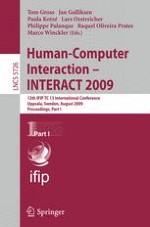INTERACT 2009 was the 12th of a series of INTERACT international c- ferences supported by the IFIP Technical Committee 13 on Human–Computer Interaction. This year,INTERACT washeld in Uppsala (Sweden), organizedby the Swedish Interdisciplinary Interest Group for Human–Computer Interaction (STIMDI) in cooperation with the Department of Information Technology at Uppsala University. Like its predecessors, INTERACT 2009 highlighted, both to the academic and to the industrial world, the importance of the human–computer interaction (HCI) area and its most recent breakthroughs on current applications. Both - perienced HCI researchers and professionals, as well as newcomers to the HCI ?eld, interested in designing or evaluating interactive software, developing new interaction technologies, or investigating overarching theories of HCI, found in INTERACT 2009 a great forum for communication with people of similar int- ests, to encourage collaboration and to learn. INTERACT 2009 had Research and Practice as its special theme. The r- son we selected this theme is that the research within the ?eld has drifted away from the practicalapplicability of its results and that the HCI practice has come to disregard the knowledge and development within the academic community.
